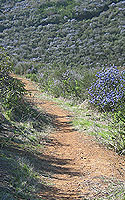Park Plants and Wildlife

Black Mountain Open Space Park is home to a wide variety of native plant and animal species. The diversity of plant communities helps to create a home for many different species of birds, mammals, amphibians, and reptiles. Visitors to Black Mountain Open Space Park can see what much of coastal southern California looked like before the onset of urban sprawl. Take time to enjoy the scents, sounds, and views. Explore quietly and perhaps you will be rewarded with the opportunity to experience the presence of some of the parks wild inhabitants.
The primary vegetation types that are found in the park are the chaparral and coastal sage scrub plant communities. The chaparral community gives the north and east side of the mountain it's beautiful "green carpet" appearance. The most common plants found in the chaparral are lemonade berry, coffee berry, chamise, manzanita, laurel sumac, toyon, and California lilac. During the early spring certain areas of the mountain will turn into a sea of blue as the flowers of the California lilac bloom. The coastal sage scrub plant community is not as dense and vibrant green as the chaparral, and is found on the dryer south and west facing slopes of the park. This plant community is made up primarily of the wonderfully aromatic white and black sage, California sagebrush, California buckwheat, and California sunflower. The coastal sage scrub is sometimes referred to as the "soft chaparral" because it is not as dense and impenetrable as chaparral. Other plant communities found within the park are native and nonnative grasslands, and a small amount of sycamore/willow riparian woodlands.
The variety of plant communities provides the needed cover and food for the wide variety of wildlife found in the park. Current surveys have revealed that over 80 species of birds can be found here, including rare species such as California Gnatcatcher, Rufous-crowned sparrow, and Northern harrier. Mammals consist of things big and small, ranging from impressive mule deer and bobcat, to smaller rodents such as desert woodrat and Pacific kangaroo rats. Reptiles and amphibians are also well represented in the park, with the moist north facing slopes and drainages that are home to Pacific chorus frogs and slender salamanders. Numerous reptiles also can be found, including the red-diamond rattlesnake.
(Remember, all plants and animals found within the park are protected and must not be harmed or removed.)

